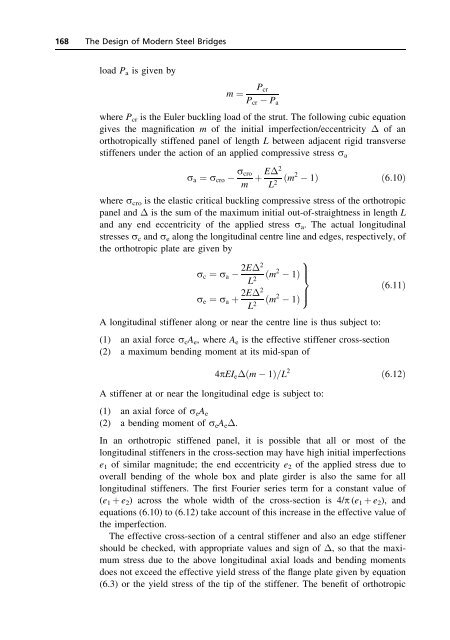The Design of Modern Steel Bridges - TEDI
The Design of Modern Steel Bridges - TEDI
The Design of Modern Steel Bridges - TEDI
You also want an ePaper? Increase the reach of your titles
YUMPU automatically turns print PDFs into web optimized ePapers that Google loves.
168 <strong>The</strong> <strong>Design</strong> <strong>of</strong> <strong>Modern</strong> <strong>Steel</strong> <strong>Bridges</strong><br />
load P a is given by<br />
m ¼ Pcr<br />
Pcr Pa<br />
where P cr is the Euler buckling load <strong>of</strong> the strut. <strong>The</strong> following cubic equation<br />
gives the magnification m <strong>of</strong> the initial imperfection/eccentricity <strong>of</strong> an<br />
orthotropically stiffened panel <strong>of</strong> length L between adjacent rigid transverse<br />
stiffeners under the action <strong>of</strong> an applied compressive stress s a<br />
sa ¼ scro<br />
scro<br />
m<br />
2 E<br />
þ ðm2<br />
L2 1Þ ð6:10Þ<br />
where scro is the elastic critical buckling compressive stress <strong>of</strong> the orthotropic<br />
panel and is the sum <strong>of</strong> the maximum initial out-<strong>of</strong>-straightness in length L<br />
and any end eccentricity <strong>of</strong> the applied stress sa. <strong>The</strong> actual longitudinal<br />
stresses sc and se along the longitudinal centre line and edges, respectively, <strong>of</strong><br />
the orthotropic plate are given by<br />
2E 2<br />
ðm 2<br />
9<br />
1Þ >=<br />
sc ¼ sa<br />
se ¼ sa þ<br />
L 2<br />
2E 2<br />
L 2 ðm 2<br />
>; 1Þ<br />
A longitudinal stiffener along or near the centre line is thus subject to:<br />
(1) an axial force s cA e, where A e is the effective stiffener cross-section<br />
(2) a maximum bending moment at its mid-span <strong>of</strong><br />
4pEIe ðm 1Þ=L 2<br />
A stiffener at or near the longitudinal edge is subject to:<br />
(1) an axial force <strong>of</strong> s eA e<br />
(2) a bending moment <strong>of</strong> s eA e .<br />
ð6:11Þ<br />
ð6:12Þ<br />
In an orthotropic stiffened panel, it is possible that all or most <strong>of</strong> the<br />
longitudinal stiffeners in the cross-section may have high initial imperfections<br />
e1 <strong>of</strong> similar magnitude; the end eccentricity e2 <strong>of</strong> the applied stress due to<br />
overall bending <strong>of</strong> the whole box and plate girder is also the same for all<br />
longitudinal stiffeners. <strong>The</strong> first Fourier series term for a constant value <strong>of</strong><br />
(e 1 þ e 2) across the whole width <strong>of</strong> the cross-section is 4/p (e 1 þ e 2), and<br />
equations (6.10) to (6.12) take account <strong>of</strong> this increase in the effective value <strong>of</strong><br />
the imperfection.<br />
<strong>The</strong> effective cross-section <strong>of</strong> a central stiffener and also an edge stiffener<br />
should be checked, with appropriate values and sign <strong>of</strong> , so that the maximum<br />
stress due to the above longitudinal axial loads and bending moments<br />
does not exceed the effective yield stress <strong>of</strong> the flange plate given by equation<br />
(6.3) or the yield stress <strong>of</strong> the tip <strong>of</strong> the stiffener. <strong>The</strong> benefit <strong>of</strong> orthotropic


